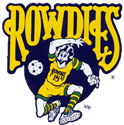![]()

NASL Soccer
Soccer
![]()
Click
Here: More
NASL Memories
In 1967, two pro soccer leagues started in the United States: the FIFA-sanctioned United Soccer Association and the unsanctioned National Professional Soccer League. It has been suggested that the timing of this was related to the huge amount of attention given throughout the English-speaking world to the victory by England in the 1966 FIFA World Cup and the resulting documentary film, Goal. The National Professional Soccer League had a national television contract in the U.S. with the CBS television network, but the ratings for matches were unacceptable even by weekend daytime standards and the arrangement was terminated. The leagues merged in 1968 to form the North American Soccer League (NASL). The league lasted until the 1984 NASL Season when it suspended operations. However, four NASL teams (Chicago, Minnesota, New York, and San Diego) joined the Major Indoor Soccer League for its 1984-85 season. The NASL itself operated an indoor soccer league from 1979-82 and in 1983-84.
The biggest club in the league and the organization's bellwether was the New York Cosmos, who drew upwards of 40,000 fans per game at their height while aging Brazilian superstar Pelé played for them. Giants Stadium sold out (74,000+) their 1977 championship win (Pelé's final professional game). However, the overall average attendance of the entire league never reached 15,000, with some clubs averaging less than 5,000.
The NASL faced challenges in regard to selling the sport of soccer to Americans, which was then completely foreign to the majority of them. The league "Americanized" the rules in the attempt to make the game more exciting, and comprehensible, to the average American sports fan. These changes included a clock that counted time down to zero as was typical of other timed American sports, rather than upwards to 45 minutes as was traditional, a 35 yard line for offsides rather than the traditional half way line, and a shootout to decide matches that ended in a draw. The foreign image of soccer was not helped, however, by a league that brought in many older, high profile foreign players, and frequently left Americans on the bench. This effort was often doubly futile, as while many of the foreign players were perhaps "big names" in their home countries, almost none of them qualifed as such in North America, and they quickly absorbed most of the available payroll, such as it was, which could have otherwise been used to pay North American players better.
Overexpansion was a huge factor in the death of the league. Once the league started growing, new franchises were awarded quickly, and it doubled in size in a few years, peaking at 24 teams. Many have suggested that cash-starved existing owners longed for their share of the expansion fee charged new owners, even though Forbes Magazine reported this amount as being only $100,000. This resulted in the available talent being spread too thinly, among other problems. Additionally, many of these new owners were not "soccer people", and once the perceived popularity started to decline, they got out as quickly as they got in. They also spent millions on aging stars to try to match the success of the Cosmos, and lost significant amounts of money in doing so.
Also, FIFA's decision to award the 1986 FIFA World Cup to Mexico after Colombia withdrew, rather than the US, is considered a factor in the NASL's demise.
While the NASL ultimately failed, it introduced soccer to the North American sports scene on a large scale for the first time and was a major contributing factor in soccer becoming the number one participatory sport among American youth. In the late-1980s, FIFA did award the World Cup to the US, which would be staged in 1994. It has also provided lessons for its successor Major League Soccer, which has tried to build soccer-specific stadiums for each of its teams, rather than following the NASL's example of depending on large NFL venues which it had little hope of ever filling. MLS has enforced a limit on foreign players, forcing teams to develop primarily American talent rather than following the NASL's example of relying on highly-paid imports who were often well past their prime (although some have criticized the league for going too far, arguing that the league needs more marketable names). Initially, MLS also tried to "Americanize" its rules with shootouts and the clock counting down, much as the NASL did, but since 2000 the league has adopted strict adherence to FIFA Laws as set by the IFAB. American college soccer still uses some NASL-style rules.
